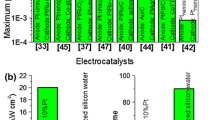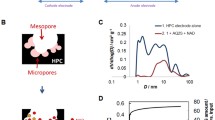Abstract
A biological fuel cell such as an oxygen/glucose cell has been considered to be an ideal power source for implantable cardiac pacemakers and similar devices. This study is mainly concerned with the development of a single oxygen/glucose cell, which can be implanted inside the body fluids with the simultaneous presence of oxidant and fuel(s). Present results ofin vitro experiments with a single oxygen/glucose cell consisting of a platinum black on platinum-mesh electrode (cathode) and a platinum black on porous-graphite electrode (anode) have shown that cell performance was markedly increased after glucose addition. Half-cell testings by means of a potentiostat coupled to a linear sweep generator also demonstrated that the anode current of a platinised graphite electrode after glucose was over 3 mA/cm2. It was also found that a steady and continuous power output of 20 μW/cm2 could be generated from the above oxygen/glucose cell. When the cell was testedin vivo in the rat. the continuous power output was steady at 3·3 μW/cm2.
The present study also investigated the possibility of generating electricity from an oxygen concentration cell and an oxygen/hydrogen cell. It was concluded that a platinum black on porous graphite electrode offers promise as a specific electrode for glucose oxidation. An oxygen/hydrogen cell could also provide a long termin vivo power supply provided the Pd-H electrode is properly encapsulated.
The significance of the present study in relation to the development of biological power sources is discussed, and the importance of fundamental investigation for the development of a specific electrode is emphasised.
Sommaire
Une cellule combustible biologique du genre oxygène/glucose, par exemple, a été considérée comme constituant une source idéale d'énergie pour les régulateurs cardiaques implantables et autres dispositifs analogues. La présente étude traite plus particulièrement de la mise au point d'une simple cellule oxygène/glucose pouvant faire l'objet d'une implantation dans les fluides corporels en présence d'un oxydant et de combustible(s). Les résults obtenus à ce jour à partir d'expériencesin vitro réalisées à l'aide d'une cellule simple d'oxygène/glucose, consistant en une électrode de toile platine enduite de noir de platine (cathode) et une électrode graphite poreux enduit de noir de platine (anode), ont permis de constater que les performances de la cellule étaient sensiblement accrues par l'adjonction de glucose. Des essais portant sur une demicellule et réalisés au moyen d'un potentiostat relié à un générateur de balayage linéaire ont également fait ressortir que le courant anodique d'une électrode de graphite platiné en présence du glucose était supérieur à 3 mA/cm2. Il a été constaté par ailleurs qu'un débit uniforme et constant de 20 μW/cm2 pouvait être assuré à partir de la cellule oxygène/glucose dont question plus haut. Lors d'un essai effectuéin vivo chez le rat, l'energie constante produite restait stationnaire à 3,3 μW/cm2.
La présente étude a également examiné la possibilité de produire de l'électricité à partir d'une cellule d'oxygène concentré et d'une cellule d'oxygène/hydrogène. Il a été constaté qu'une électrode de graphite poreux enduit de noir de platine pourrait constituer une électrode spécifique pour l'oxydation du glucose. Une cellule oxygène/hydrogène pourrait en outre assurer une alimentation en energie de longue duréein vivo, à condition que l'électrode Pd-H soit bien enrobée.
La conséquence de la présente étude pour le développement de sources biologiques d'énergie fait l'objet d'une discussion, et l'auteur insiste sur l'importance que revêt la nécessité d'entreprendre des travaux de recherche fondamentale ayant pour objet de mettre au point une électrode spécifique.
Zusammenfassung
Eine biologische Brennstoffzelle wie z.B. eine Sauerstoff-Glukose-Zelle würde eine ideale Kraftquelle für implantierte Herzschrittmacher und ähnliche Geräte darstellen. Diese Arbeit beschäftigt sich hauptsächlich mit der Entwicklung einer einzelnen Sauerstoff-Glukose-Zelle, welche innerhalbe der Körperflüssigkeiten mit gleichzeitiger Anwesenheit von Sauerstoff und Brennstoffen implantiert werden kann. Gegenwärtige Ergebnisse vonin vitro Experimenten mit einer einzelnen Sauerstoff-Glukose-Zelle, die aus Platinschwärze auf einer Platinnetzelektrode (Kathode) und Platinschwärze auf einer porösen Grafitelektrode (Anode) besteht, haben ergeben, dass die Zellenleistung wesentlich höher durch Glukosezugabe wurde. Halbzellenversuche mittels eines an einen Sweepgenerator angeschlossenen Potentiostats haben ebenfalls gezeigt, dass der Anodenstrom einer platinisierten Grafitelektrode nach Glukosezugabe über 3 mA/cm2 betrug. Es wurde weiterhin gefunden, dass eine gleichmässige und dauernde Ausgangsleistung von 20 μW/cm2 von der obigen Sauerstoff-Glukose-Zelle erzeugt werden kann. Beiin vivo Tests in einer Ratte war die gleichmässige Dauerleistung bei 3,3 μW/cm2.
Die Bedeutung der vorliegenden Studie hinsichtlich der Entwicklung von biologischen Kraftquellen wird diskutiert und die Wichtigkeit der Grundlagenforschung für die Entwicklung einer spezifischen Elektrode wird betont.
Similar content being viewed by others
References
Drake, R. F. (1968) Second Annual Summary, Report—Implantable fuel cell for an artificial heart. Contract No. PH43-66-967. Monsanto Research Corp., Everett, Mass., USA.
Drake R. F. (1969) Implantable fuel cell for artificial heart. Proceedings of artificial heart program conference, 9th–13th June. Washington, DC, USA. 869–879.
Drake, R. F., Kusserow, B. K., Messinger, S. andMatsuda, S. (1970) A tissue implantable fuel cell power supply.Trans. Am. Soc. Artif. Intern. Organs 16 (1), 99–205.
Giner, J. andMalachestky, P. (1969) Anodic oxidation of glucose. Proceedings of artificial heart program conference, 9th–13th June. Washington, DC, USA. 83–848.
Konikoff, J. J. (1969)In vivo energy sources. InAdvances in biomedical engineering and medical physics. 341–371. (Editor:S. N. Levine.) Interscience Publishers. New York and London.
Kozawa, A., Zilionis, V., Brodd, R. andPowers, R. (1969) Search for a specific catalyst for electrochemical oxygen reduction in neutral NaCl solution. Proceedings of artificial heart program conference. 9th–13th June. Washington, DC, USA. 849–860.
Massie, H., Racie, P., Parker, R., Hanh, A. W. andSun, H. H. (1968) Study of power generating implantable electrodes.Med. & Biol. Engng. 6, 503–516.
Tantram, A. D. S. andTseung, A. C. C. (1969) Structure and performance of hydrophobic electrodes.Nature 221, 167–168.
Tseung, A. C. C., King, W. J. andWan, B. Y. C. (1971) An encapsulated, implantable metal-oxygen cell as a long-term power source for medical and biological applications.Med. & Biol. Engng. 9, 175–184.
Warner, H. andRobinson, B. W. (1967) A glucose cell. Digest of the 7th international conference on medical and biological engineering. Stockholm. 520.
Wolfson, S. K., Jr., Gofberg, S. L., Prusiner, P. andNanis, L. (1968) The bioautofuel cell: a device for pacemaker power from direct energy conversion consuming autogenous fuel.Trans. Am. Soc. Artif. Intern. Organs. 14, 198–209.
Author information
Authors and Affiliations
Rights and permissions
About this article
Cite this article
Wan, B.Y.C., Tseung, A.C.C. Some studies related to electricity generation from biological fuel cells and galvanic cells,in vitro andin vivo . Med. & biol. Engng. 12, 14–28 (1974). https://doi.org/10.1007/BF02629831
Received:
Accepted:
Issue Date:
DOI: https://doi.org/10.1007/BF02629831




